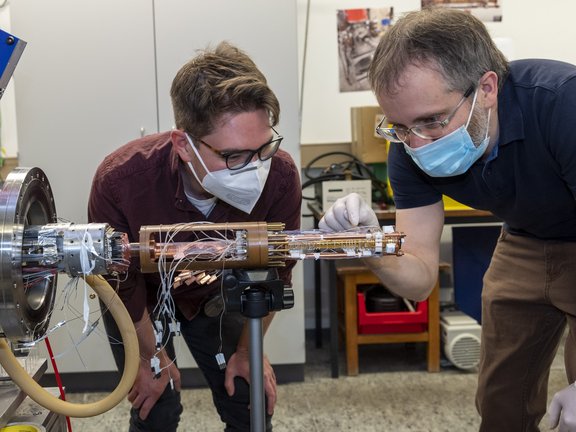Precise measurements on individual ions require that they are enclosed and stored in a trap with as little motion as possible. To do this, you have to remove energy from the charged particles, which reduces their temperature. With the new two-trap setup, the research team was able to lower the temperature by about a factor of 10 compared to the best cooling method for protons to date, thus achieving a temperature close to absolute zero. “The lower the temperature of the particle, the more precisely we can restrict the volume in which the particle is in the trap. The more precisely we can localise the particle, the better the starting conditions are defined and the more accurate the measurement subsequently will be,” explains Christian Smorra, physicist at the PRISMA+ Excellence Cluster.
Killing two birds with one stone
The new two-trap cooling method offers several advantages: Firstly, it also works with antimatter particles, because in a single-trap cooling system, matter and antimatter would immediately annihilate each other. Thus, a more precise comparison of protons and antiprotons will be possible. “We want to specifically look for any difference between the properties of protons and antiprotons. Our theory says that the two particles behave identically except for the opposed charge. But is still unclear why our universe contains so many protons – and thus matter – but almost no antiprotons, i.e. antimatter,” points out Matthew Bohman from MPIK, first author of the study.
Another advantage: While previously applied methods required distances of 0.1 millimetres or less between the particles to be cooled and the beryllium ions, the current work has succeeded in transferring the cooling power over a distance of nine centimetres. This creates the prerequisite for further research projects – and allows interference-free and more precise measurements, as the BASE collaboration would also like to do in the search for dark matter with the help of antimatter. To this end, the research group had already investigated trapped antiprotons in earlier experiments at CERN – but by cooling them with liquid helium and without the help of beryllium ions.
“Practically feasible development”
The two-trap method was first proposed in 1990. In the concept at the time, no electric resonant circuit was envisaged – here, the ions were to be connected by a common trap electrode. The advantage of this approach: There is no resistance, as is the case with an oscillating circuit. This produces heat and weakens the cooling process. The big disadvantage, however, is the low speed at which the energy of the ions is exchanged. As a result, the temperature of the charged particle does not drop fast enough. “The current implementation represents a practically feasible development of the 1990 concept. Instead of taking place within two minutes, the energy exchange between the traps here takes place within one second,” stresses Christian Smorra.
Original publication:
Sympathetic cooling of a trapped proton mediated by an LC circuit, M. Bohman V. Grunhofer, C. Smorra, M. Wiesinger, C. Will, M. J. Borchert, J. A. Devlin, S. Erlewein, M. Fleck, S. Gavranovic, J. Harrington, B. Latacz, A. Mooser, D. Popper, E. Wursten, K. Blaum, Y. Matsuda, C. Ospelkaus, W. Quint, J. Walz, and S. Ulmer, Nature 596, 514 (2021), DOI: 10.1038/s41586-021-03784-w
BASE: Baryon Antibaryon Symmetry Experiment at CERN
